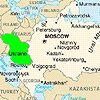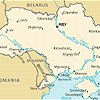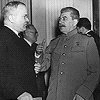
Joseph Stalin, leader of the Soviet Union, set in motion events designed to cause a famine in the Ukraine to destroy the people there seeking independence from his rule. As a result, an estimated 7,000,000 persons perished in this farming area, known as the breadbasket of Europe, with the people deprived of the food they had grown with their own hands.
The Ukrainian independence movement actually predated the Stalin era. Ukraine, which measures about the size of France, had been under the domination of the Imperial Czars of Russia for 200 years. With the collapse of the Czarist rule in March 1917, it seemed the long-awaited opportunity for independence had finally arrived. Optimistic Ukrainians declared their country to be an independent People's Republic and re-established the ancient capital city of Kiev as the seat of government.
However, their new-found freedom was short-lived. By the end of 1917, Vladimir Lenin, the first leader of the Soviet Union, sought to reclaim all of the areas formerly controlled by the Czars, especially the fertile Ukraine. As a result, four years of chaos and conflict followed in which Ukrainian national troops fought against Lenin's Red Army, and also against Russia's White Army (troops still loyal to the Czar) as well as other invading forces including the Germans and Poles.
By 1921, the battles ended with a Soviet victory while the western part of the Ukraine was divided-up among Poland, Romania, and Czechoslovakia. The Soviets immediately began shipping out huge amounts of grain to feed the hungry people of Moscow and other big Russian cities. Coincidentally, a drought occurred in the Ukraine, resulting in widespread starvation and a surge of popular resentment against Lenin and the Soviets.
To lessen the deepening resentment, Lenin relaxed his grip on the country, stopped taking out so much grain, and even encouraged a free-market exchange of goods. This breath of fresh air renewed the people's interest in independence and resulted in a national revival movement celebrating their unique folk customs, language, poetry, music, arts, and Ukrainian orthodox religion.
But when Lenin died in 1924, he was succeeded by Joseph Stalin, one of the most ruthless humans ever to hold power. To Stalin, the burgeoning national revival movement and continuing loss of Soviet influence in the Ukraine was completely unacceptable. To crush the people's free spirit, he began to employ the same methods he had successfully used within the Soviet Union. Thus, beginning in 1929, over 5,000 Ukrainian scholars, scientists, cultural and religious leaders were arrested after being falsely accused of plotting an armed revolt. Those arrested were either shot without a trial or deported to prison camps in remote areas of Russia.
Stalin also imposed the Soviet system of land management known as collectivization. This resulted in the seizure of all privately owned farmlands and livestock, in a country where 80 percent of the people were traditional village farmers. Among those farmers, were a class of people called Kulaks by the Communists. They were formerly wealthy farmers that had owned 24 or more acres, or had employed farm workers. Stalin believed any future insurrection would be led by the Kulaks, thus he proclaimed a policy aimed at "liquidating the Kulaks as a class."
Declared "enemies of the people," the Kulaks were left homeless and without a single possession as everything was taken from them, even their pots and pans. It was also forbidden by law for anyone to aid dispossessed Kulak families. Some researchers estimate that ten million persons were thrown out of their homes, put on railroad box cars and deported to "special settlements" in the wilderness of Siberia during this era, with up to a third of them perishing amid the frigid living conditions. Men and older boys, along with childless women and unmarried girls, also became slave-workers in Soviet-run mines and big industrial projects.
Back in the Ukraine, once-proud village farmers were by now reduced to the level of rural factory workers on large collective farms. Anyone refusing to participate in the compulsory collectivization system was simply denounced as a Kulak and deported.
A propaganda campaign was started utilizing eager young Communist activists who spread out among the country folk attempting to shore up the people's support for the Soviet regime. However, their attempts failed. Despite the propaganda, ongoing coercion and threats, the people continued to resist through acts of rebellion and outright sabotage. They burned their own homes rather than surrender them. They took back their property, tools and farm animals from the collectives, harassed and even assassinated local Soviet authorities. This ultimately put them in direct conflict with the power and authority of Joseph Stalin.
Soviet troops and secret police were rushed in to put down the rebellion. They confronted rowdy farmers by firing warning shots above their heads. In some cases, however, they fired directly at the people. Stalin's secret police (GPU, predecessor of the KGB) also went to work waging a campaign of terror designed to break the people's will. GPU squads systematically attacked and killed uncooperative farmers.
But the resistance continued. The people simply refused to become cogs in the Soviet farm machine and remained stubbornly determined to return to their pre-Soviet farming lifestyle. Some refused to work at all, leaving the wheat and oats to rot in unharvested fields. Once again, they were placing themselves in conflict with Stalin.
In Moscow, Stalin responded to their unyielding defiance by dictating a policy that would deliberately cause mass starvation and result in the deaths of millions.
By mid 1932, nearly 75 percent of the farms in the Ukraine had been forcibly collectivized. On Stalin's orders, mandatory quotas of foodstuffs to be shipped out to the Soviet Union were drastically increased in August, October and again in January 1933, until there was simply no food remaining to feed the people of the Ukraine.
Much of the hugely abundant wheat crop harvested by the Ukrainians that year was dumped on the foreign market to generate cash to aid Stalin's Five Year Plan for the modernization of the Soviet Union and also to help finance his massive military buildup. If the wheat had remained in the Ukraine, it was estimated to have been enough to feed all of the people there for up to two years.
Ukrainian Communists urgently appealed to Moscow for a reduction in the grain quotas and also asked for emergency food aid. Stalin responded by denouncing them and rushed in over 100,000 fiercely loyal Russian soldiers to purge the Ukrainian Communist Party. The Soviets then sealed off the borders of the Ukraine, preventing any food from entering, in effect turning the country into a gigantic concentration camp. Soviet police troops inside the Ukraine also went house to house seizing any stored up food, leaving farm families without a morsel. All food was considered to be the "sacred" property of the State. Anyone caught stealing State property, even an ear of corn or stubble of wheat, could be shot or imprisoned for not less than ten years.
Starvation quickly ensued throughout the Ukraine, with the most vulnerable, children and the elderly, first feeling the effects of malnutrition. The once-smiling young faces of children vanished forever amid the constant pain of hunger. It gnawed away at their bellies, which became grossly swollen, while their arms and legs became like sticks as they slowly starved to death.
Mothers in the countryside sometimes tossed their emaciated children onto passing railroad cars traveling toward cities such as Kiev in the hope someone there would take pity. But in the cities, children and adults who had already flocked there from the countryside were dropping dead in the streets, with their bodies carted away in horse-drawn wagons to be dumped in mass graves. Occasionally, people lying on the sidewalk who were thought to be dead, but were actually still alive, were also carted away and buried.
While police and Communist Party officials remained quite well fed, desperate Ukrainians ate leaves off bushes and trees, killed dogs, cats, frogs, mice and birds then cooked them. Others, gone mad with hunger, resorted to cannibalism, with parents sometimes even eating their own children.
Meanwhile, nearby Soviet-controlled granaries were said to be bursting at the seams from huge stocks of 'reserve' grain, which had not yet been shipped out of the Ukraine. In some locations, grain and potatoes were piled in the open, protected by barbed wire and armed GPU guards who shot down anyone attempting to take the food. Farm animals, considered necessary for production, were allowed to be fed, while the people living among them had absolutely nothing to eat.
By the spring of 1933, the height of the famine, an estimated 25,000 persons died every day in the Ukraine. Entire villages were perishing. In Europe, America and Canada, persons of Ukrainian descent and others responded to news reports of the famine by sending in food supplies. But Soviet authorities halted all food shipments at the border. It was the official policy of the Soviet Union to deny the existence of a famine and thus to refuse any outside assistance. Anyone claiming that there was in fact a famine was accused of spreading anti-Soviet propaganda. Inside the Soviet Union, a person could be arrested for even using the word 'famine' or 'hunger' or 'starvation' in a sentence.
The Soviets bolstered their famine denial by duping members of the foreign press and international celebrities through carefully staged photo opportunities in the Soviet Union and the Ukraine. The writer George Bernard Shaw, along with a group of British socialites, visited the Soviet Union and came away with a favorable impression which he disseminated to the world. Former French Premier Edouard Herriot was given a five-day stage-managed tour of the Ukraine, viewing spruced-up streets in Kiev and inspecting a 'model' collective farm. He also came away with a favorable impression and even declared there was indeed no famine.
Back in Moscow, six British engineers working in the Soviet Union were arrested and charged with sabotage, espionage and bribery, and threatened with the death penalty. The sensational show trial that followed was actually a cynical ruse to deflect the attention of foreign journalists from the famine. Journalists were warned they would be shut out of the trial completely if they wrote news stories about the famine. Most of the foreign press corp yielded to the Soviet demand and either didn't cover the famine or wrote stories sympathetic to the official Soviet propaganda line that it didn't exist. Among those was Pulitzer Prize winning reporter Walter Duranty of the New York Times who sent one dispatch stating "...all talk of famine now is ridiculous."
Outside the Soviet Union, governments of the West adopted a passive attitude toward the famine, although most of them had become aware of the true suffering in the Ukraine through confidential diplomatic channels. In November 1933, the United States, under its new president, Franklin D. Roosevelt, even chose to formally recognized Stalin's Communist government and also negotiated a sweeping new trade agreement. The following year, the pattern of denial in the West culminated with the admission of the Soviet Union into the League of Nations.
Stalin's Five Year Plan for the modernization of the Soviet Union depended largely on the purchase of massive amounts of manufactured goods and technology from Western nations. Those nations were unwilling to disrupt lucrative trade agreements with the Soviet Union in order to pursue the matter of the famine.
By the end of 1933, nearly 25 percent of the population of the Ukraine, including three million children, had perished. The Kulaks as a class were destroyed and an entire nation of village farmers had been laid low. With his immediate objectives now achieved, Stalin allowed food distribution to resume inside the Ukraine and the famine subsided. However, political persecutions and further round-ups of 'enemies' continued unchecked in the years following the famine, interrupted only in June 1941 when Nazi troops stormed into the country. Hitler's troops, like all previous invaders, arrived in the Ukraine to rob the breadbasket of Europe and simply replaced one reign of terror with another.
Copyright © 2000 The History Place™ All Rights Reserved
![]()
Terms of use: Private home/school non-commercial, non-Internet re-usage only is allowed of any text, graphics, photos, audio clips, other electronic files or materials from The History Place.


